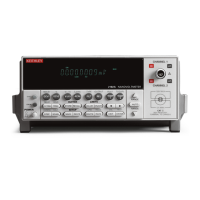12-10 Common Commands
*OPC? – Operation Complete Query Place a “1” in the output queue after all
pending operations are completed
Description
When this common command is sent, an ASCII “1” will be placed in the Output Queue after
the last pending operation is completed. When the Model 2182 is then addressed to talk, the “1”
in the Output Queue will be sent to the computer.
The “1” in the Output Queue will set the MAV (Message Available) bit (B4) of the Status
Byte Register. If the corresponding bit (B4) in the Service Request Enable Register is set, the
RQS/MSS (Request for Service/Master Summary Status) bit in the Status Byte Register will set.
When used with the Initiate Immediately command (:INITiate), a “1” will not be placed into
the Output Queue until the Model 2182 goes back into the idle state. The :INIT command
operation is not considered finished until the Model 2182 goes back into the idle state. See the
description for *WAI for more information on command execution.
The execution of OPC? is not completed until it has placed the “1” in the Output Queue.
To use *OPC? exclusively with the *TRG command, first force the completion of the initiate
command so that only the *TRG command is pending. To do this, send the :ABORt command
to place the instrument in idle, which (by definition) completes the initiate command. Since
continuous initiation is on, operation continues on into the Trigger Model. After sending the
*TRG command, an ASCII “1” is placed in the Output Queue and the MAV bit sets when the
*TRG command is finished.
After *OPC? is executed, additional commands cannot be sent to the Model 2182 until the
pending overlapped commands are finished. For example, :INITiate:CONTinuous ON followed
by *OPC? locks up the instrument and requires a device clear (DCL or SDC) before it will
accept any more commands.
NOTE See *OPC, *TRG, and *WAI for more information.
Programming example – The following command sequence demonstrates how to use
*OPC? to signal the end of a measurement process:
SYST : PRES ‘ Returns 2182 to default setup.
INIT : CONT OFF ‘ Disables continuous initiation.
ABORt ‘ Aborts operation. Places 2182 in idle.
TRIG : COUN 1 ‘ These two commands configure the 2182
SAMP : COUN 5 ‘ to perform five measurements.
INIT ‘ Starts measurement process.
*OPC? ‘ Sends the OPC? command
After all five measurements are performed and the instrument returns to idle state, an ASCII
‘1’ will be placed in the Output Queue. After addressing the Model 2182 to talk, the ‘1’ from the
Output Queue is sent to the computer.
SYST : PRES ‘ Returns 2182 to default setup.

